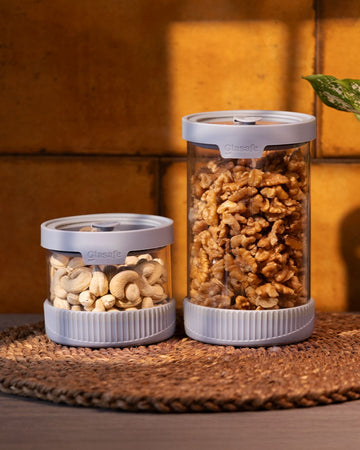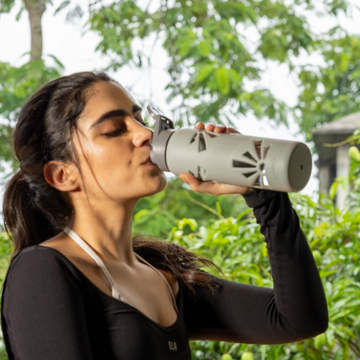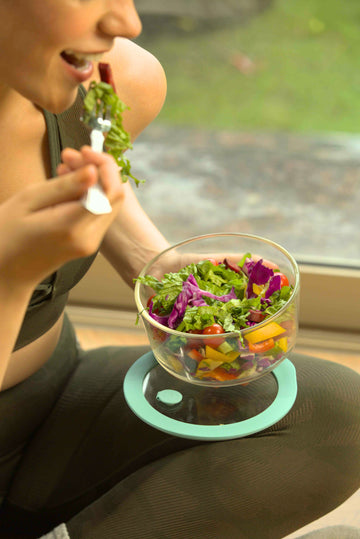Dry fruits and nuts, like almonds, cashews, raisins, pistachios, walnuts, dates, etc., are nutritional powerhouses. But one thing many of us struggle with is maintaining their freshness. It’s disheartening when your almonds go stale, or your raisins become sticky, or your nuts develop that off smell.
We at Glasafe consider appropriate storage to be both an art and a science. Our borosilicate glass storage jars and glass kitchen storage containers are made to prolong the nutrients, tastes, and textures of your dried fruits and nuts. In this blog, we will know all the best practices, dos and don'ts, and how to pick storage that will help you win the fight of everyday freshness with proper storage.
Why It's Difficult to Properly Store Dry Fruits & Nuts
Let's first know the reasons why dry fruits and nuts deteriorate or lose their quality before moving on to the "how":
-
Humidity and moisture: Despite being "dry," these objects nevertheless absorb ambient moisture, which can render them mushy or lead to mold growth if excessive moisture is present.
-
Oxygen/oxidation: When exposed to air, the oils and lipids in nuts turn rancid. Oxidation is further accelerated by oxygen.
-
Light/UV: Strong indoor lighting or sunlight can destroy vitamins, oils, and flavor.
-
Heat and temperature variations: Excessive heat accelerates spoiling reactions. Warm, erratic temperatures are dangerous.
-
Insects and pests: If containers aren't properly sealed, pantry pests like beetles and weevils may infiltrate.
-
Odors and cross-contamination: Nuts and dried fruits tend to absorb or transfer aromas from their surroundings.
Low moisture, little oxygen, a steady, moderate temperature, dark or opaque protection, and airtight pest-proofing are the optimum conditions to keep them fresh.
Best Practices for Longer Shelf Time of Dry Fruits
Here is a “master checklist” you can follow when storing your dry fruits or nuts.
|
Principle |
What to Do |
Why It Matters |
|
Start with quality |
Buy fresh, good-quality nuts/dry fruits. Avoid items already stale or moldy. |
You can’t reverse pre-existing spoilage. |
|
Remove debris / broken shells |
Sort out broken bits, husks, foreign matter before storage. |
These often harbor moisture or microbial contamination. |
|
Dry thoroughly |
If your dry fruits were washed or damp, dry them thoroughly (sun, shade, or gentle heat). |
Moist surfaces invite mold and bacteria. |
|
Portion wisely |
Don’t store your entire stock in one large container; use smaller portions. |
Reduces repeated exposure to air. |
|
Airtight sealing |
Use containers with airtight lids (silicone gasket, clamp lids, good seals). |
Prevents ingress of moisture, oxygen, insects. |
|
Cool, stable temp |
Keep in cool, dark place (pantry, cupboard, ideal ~15–25 °C). Avoid near stoves, ovens or direct sunlight. |
Slows down chemical spoilage. |
|
Optional refrigeration / freezing |
For long-term storage (6+ months), you can refrigerate or freeze (in airtight jars). |
Cold slows oxidation drastically. |
|
Label & rotate |
Label with date, use “first in, first out” (FIFO). |
Prevents old batches from languishing. |
|
Inspect periodically |
Check for moisture, pests, smell change every few weeks. |
Early detection lets you discard or salvage. |
Poor quality or humidity storage cannot be miraculously fixed by even the best container. However, the container can perform its function effectively with these techniques.
Why Choose Glass Storage Options from Glasafe?
At Glasafe, we carefully considered those spoiling variables when designing our borosilicate glass jars and glass kitchen storage containers. Allow us to explain the properties and how they contribute to the freshness of your dry fruits and nuts.
-
Borosilicate glass body: The containers are composed entirely of borosilicate glass, which is non-porous, more resistant to temperature changes, and does not retain stains or smells. That means there won't be any flavor absorption or lingering odors from spices or other things you store in nuts and dry fruits.
-
Airtight lids: Every container has an airtight lid. This is necessary to keep out oxygen and moisture, two of freshness's main enemies.
-
Silicone protection: A detachable silicone sleeve and base around the glass body, which offers anti-slip security and impact protection, lowering the chance of breakage from bumps. This implies that you can handle full jars with assurance and not worry about dropping them.
-
BPA-free, stain-resistant, and odorless: There is no plastic tang or contamination, and the materials don't absorb or leak smells.
-
Stackable and space-saving: The shapes are made to fit neatly on a shelf or in your pantry. That saves room and keeps you well-organized.
-
Dishwasher-safe: Particularly useful if there is still oil residue or when alternating between different nuts or dry fruits. Note: the top rack is the ideal place to wash lids.
-
Various sizes: Jars for little to large volumes range in capacity from 250ml to 1200ml. For example:
-
250ml is ideal for tiny seeds, nuts, and raisins.
Glasafe glass containers with silicone protection allow you to manage all the elements that contribute to spoiling, including moisture, oxygen, light, and ease of handling. They provide you with a trustworthy protective shell, but they are not magic; you still need to follow the proper procedures.
How to Preserve the Freshness of Nuts?
Here's a thorough, approachable tutorial on how to preserve the freshness of dry fruits and nuts in Glasafe jars or any high-quality glass jar for maximum freshness.
Step 1: Acquire and arrange
-
Purchase from a reliable supplier; look for bugs, rancidity, age, and scent.
-
As soon as you arrive, smell and check.
-
Sort according to type, such as cashews and almonds.
-
Take out the husks, stones, broken pieces, and shells.
Step 2: If necessary, pre-dry
Spread the nuts or dry fruits on a tray in the shade or light sunlight (or in a dehydrator or oven set to a low temperature of about 40 to 50 degrees Celsius) until they are just dried if they feel a little wet or have been cleaned. Don't let it get too hot.
Step 3: Divide among jars
-
For smaller amounts, use a 250 ml Glasafe jar; for bigger batches, use a 600 or 900ml jar.
-
Don't overfill; instead, leave 1-2 cm of room at the top to ensure there isn't much air space.
-
Instead of filling a large jar, split a large batch into two smaller ones.
Step 4: Label and seal
-
Make sure the silicone gasket, if it's there, is seated properly before placing the lid.
-
Press until the seal is felt or heard.
-
Put the type and storage date on the label.
Step 5: Keep in the best possible conditions
-
Steer clear of warm appliances and bright sunlight, and store the jars in a cold, dark cupboard or cabinet.
-
Avoid placing shelves next to stoves, ovens, or microwaves.
-
Jars can be stored for a long time in the refrigerator or freezer if your climate is warm or extremely humid.
Step 6: Freezing or refrigeration is optional
-
Store sealed glass container in the freezer or refrigerator to delay oxidation if you plan to keep them for three to twelve months.
-
Make sure the container is sealed and that the lid doesn't collapse to prevent condensation.
-
To prevent moisture from condensing within, remove from the freezer and allow to come to room temperature before opening.
Step 7: Rotate and use wisely
-
Apply the first-in, first-out (FIFO) strategy.
-
Try to finish a jar within a few weeks of opening it.
-
After every use, tightly reseal.
-
To minimize air space, if you open the jar in the middle, think about transferring the remaining contents to a smaller jar.
Step 8: Conduct routine inspections
-
Check for wetness, changes in fragrance, and the presence of insects once every two to three weeks.
-
If moisture is visible, open and let it air dry before resealing.
-
Throw away right away if there's a musty or rancid scent.
Step 9: Contents cleaning and switching
-
Before moving on to the next nut or dry fruit, clean the container after using it up.
-
If there is a silicone sleeve, remove it and wash with warm, soapy water.
-
Soak the glass in vinegar and water to remove stains or smells, then give it a gentle scrub.
-
Before use, let everything completely dry. Mild cleaning techniques are advised by Glasafe's recommendations.
Storage Advice for Particular Types of Nuts & Dry Fruits
Here are some further pointers tailored to various climate zones, usage habits, and nuts/dry fruits.
High-oily nuts (pecans, walnuts)
These are more prone to becoming rancid:
-
Keep in smaller containers.
-
For long-term storage, choose cold storage (freezer or refrigerator).
-
For extended storage, include an oxygen absorber pack.
Flax, chia, and sesame seeds
Even more delicate: use low temperatures, sealed jars, and use in batches within three to six months.
Dates, figs, and raisins
If too dry, they may solidify, and if too wet, they may develop mold:
-
Store in a rice sachet (separated apart to prevent contact) or a small amount of food-grade silica gel.
-
To preserve natural moisture while keeping out outside humidity, use jars that shut tightly.
Humid and tropical conditions (such as those in Hyderabad)
-
Anticipate increased ambient humidity; use air-conditioned storage spaces or a dehumidifier.
-
For other sorts, think about refrigeration.
-
Before sealing, dry the jar rims.
Combining dry fruits and nuts
Nuts might be affected by the moisture and sugars in fruits, so don't combine them unless you plan to eat them right away.
Common Mistakes and Preventive Measures
Using flimsy containers or plastic can let air in or cause scents to leak out. Glasafe's glass + silicone method is therefore better.
-
Jar overfilling → Excess air space accelerates oxidation.
-
Inadequate sealing → Always inspect the gasket and keep dust out of the seal.
-
Heat stress cannot be prevented by even the best jars when stored in close proximity to heat sources or direct sunshine.
-
Ignoring pests and doing infrequent inspections → An entire batch can be ruined by a minor invasion of insects.
-
When jars are switched without being cleaned, any leftover oil or odor may remain.
-
Avoid moving a cold jar quickly to a heated area since it could cause thermal shock to the glass.
Why Glasafe Storage Containers are Better Than Other Jars?
Here is a brief synopsis that you might utilize for comparison or recommendation:
-
Resistance to thermal shock: Compared to regular glass, borosilicate glass can withstand temperature changes better.
-
Non-porous and odorless: Unlike certain polymers, it doesn't hold onto odors or stains.
-
Better protection from moisture and oxygen is provided by airtight lids and silicone seals.
-
Protective sleeves: Provide grip safety and lessen breaking.
-
Simple cleaning: Dishwasher-safe and little maintenance.
To put it briefly, you get the qualities you require (durability, inertness, and airtightness) in jars that are both stylish and useful.
Dry Fruits Storage Plan for Homes
This is how someone could schedule their storage for a period of six months:
-
Get 5 kg of almonds, 2 kg of cashews, 1 kg of walnuts, and 1 kg of raisins.
-
Clean, sort, and pre-dry.
-
Leave headroom when filling several Glasafe 900 ml or 1200 ml jars.
-
Put the date on the label.
-
Keep one jar of walnuts in the refrigerator and three jars of almonds, cashews, and raisins in the pantry.
-
Three months later, open and check. If half consumed, transfer some to smaller jars.
-
Continue until consumption and re-label.
That way, even after months, you will probably still have almost complete flavor and crunch.
Nuts and dry fruits are valuable, and proper storage is just as crucial as proper purchase. Crisp, tasty nuts and fruits can be enjoyed for a long time after purchase with the correct strategy, astute storage techniques, and premium containers like Glasafe jars.
FAQs
Should dry fruits be stored in the fridge?
Yes, dry fruits can be stored in the fridge to extend their shelf life, especially in hot, humid climatic regions. Store them in a well-sealed, airtight container to prevent them from absorbing other food flavors and keep them fresh for longer, for several months to a year, depending on the type of dried fruit.
How to store dry fruits at home without a fridge?
To store dry fruits without a fridge, keep them in airtight containers away from heat, light, and moisture. A cool, dry pantry or cupboard is ideal; you can also add a small piece of dry bread or a silica gel packet to absorb excess moisture.
Where is the best place to store dried fruit?
The best place to store dried fruit is in an airtight container in a cool, dry, and dark place, such as a pantry or cupboard, to prevent moisture, heat, and light from causing spoilage or degradation. You can use the freezer for longer storage, especially in hot and humid climate.
Do dry fruits expire if not refrigerated?
Yes, dry fruits will expire even without refrigeration, though refrigeration can significantly extend their shelf life by slowing down oxidation and moisture absorption.
Which dry fruit has the most benefits?
Almonds for heart health and protein, walnuts for brain health and omega-3s, dates for natural energy and fiber, and pistachios for their high fiber and protein content are just a few examples; there is no one "most beneficial" dry fruit. It depends on your nutritional requirements on which dry fruits to choose.
What are the top 3 healthiest nuts?
The three healthiest nuts are almonds, known for vitamin E and magnesium, walnuts, rich in omega-3 fatty acids, and pistachios, which are high in antioxidants and have the fewest calories of the popular nuts.
Which dry fruit is rich in omega-3?
Walnuts are the dry fruit highest in omega-3 fatty acids, but other options like flax seeds, peanuts, and pistachios also contain them. These healthy fats, specifically alpha-linolenic acid (ALA), are beneficial for heart and brain health.
How do you know if dried fruit has gone bad?
If it shows signs of mold, has an off or sour smell, has a sticky or slimy texture, or has unusual discoloration, you know it has gone bad.
Should you freeze the dry fruits?
Yes, you should freeze-dry fruit for its extended shelf life, excellent nutrient retention, and convenient, portable form, making it an ideal choice for long-term storage and healthy snacks.
When should you not eat dry fruit?
You should not eat dry fruit late at night, on an empty stomach, or in large quantities, especially if you have diabetes, a fruit allergy, or are trying to lose weight.
How many walnuts per day?
A healthy daily serving of walnuts is around 28-56 grams or 14-28 halves, according to a balanced diet.
How many almonds should I eat per day?
You should eat about 8-10 soaked almonds daily for general health benefits, though the ideal amount can vary, with some sources suggesting 23-30gm per day.
Which dry fruits contain vitamin B12?
While dry fruits like nuts and seeds can be nutritious, they are not natural sources of Vitamin B12. Vitamin B12 is primarily found in animal-based products such as dairy, meat, and fish or fortified foods.




